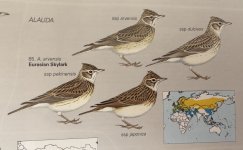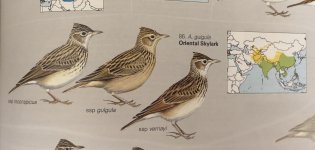Thank you very much for your valuable comments Graham,
I think the pp is too short for a typical eurasian skylark. As far as I know, the length of pp beyond tertials is an ID criteria instead of number of exposing tips of primaries (?) Agree, bill is too short for oriental skylark. When we look at the overall colouration, I see the outermost tail feathers are buff, instead of white. It seems white but I think it is caused by highlight blowing (wrong exposure). I see “L” shape on the face of the bird, which is not typical for eurasian skylark.
I took many pictures at same location, on same day and only this bird was different as in structure and plumage. I share some more pictures (Not sure same bird, but almost same time), the stance of the bird is too upright for an euraisian skylark (?) and a trio of skylarks which shows coloration differences (May be age related?)
On the other hand, I looked at the subspecies of the skylark, which were previously recorded in Turkey: all breeding bird in southeast belongs to A. a. armenica. But the northeast birds belong to A. a. canterella (although wing length some what longer). But in winter nominate ssp and A. a. dulcivox was also recored within the region.
In adition to that; oriental skylark’s “inconspicua” subspecies found in eastern parts of Iran etc. This ssp is lighter in plumage colouration and is the most probable ssp in winter in Turkey. I understand it is almost impossible to tell the ssp from some photos, but discussing and sharing the findings may be hepful for future records.















